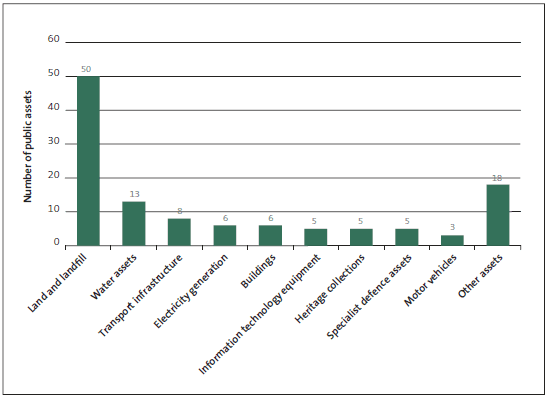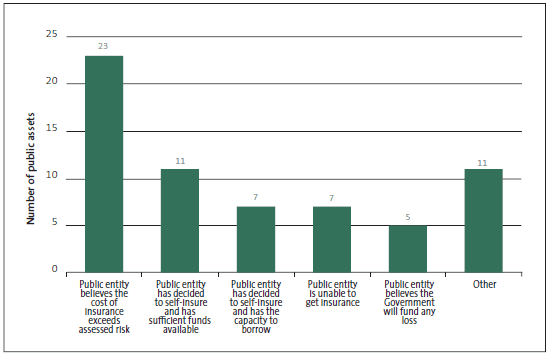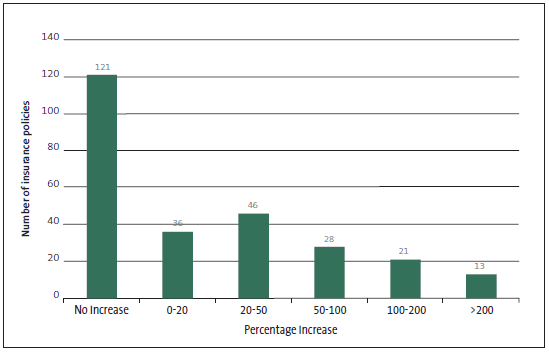Part 3: Analysis of insurance for central government assets
3.1
In this Part, we set out our analysis of the information about insurance of assets that we collected from central government entities. We look at:
- the value of assets in central government;
- the extent of insurance for those assets;
- why some assets are not insured;
- the level of cover for insured assets;
- alternative approaches for acquiring insurance; and
- changes in insurance in central government after 2010.
Value of central government assets
3.2
We collected information about the insurance of assets for about 200 central government entities. Appendix 2 sets out the number and types of these entities. In total, these public entities' financial statements have assets recorded at about $113 billion. We refer to this as the carrying value of those assets. Figure 11 shows that government departments, State-owned enterprises, and other Crown entities together hold most central government assets.
Figure 11
Carrying value of central government assets, in billions of dollars, by type of entity

Extent of insurance cover for central government assets
3.3
The information we collected indicates that about half of central government assets have insurance cover. If we exclude land, we estimate that about two-thirds of the remaining assets have insurance cover. Insurance cover on these assets costs about $180 million a year in insurance premiums. Most public entities negotiate their insurance cover individually.
3.4
This leaves many central government assets without insurance cover. A few public entities hold most of these uninsured assets. They are the New Zealand Transport Agency, Department of Conservation, and New Zealand Defence Force. Figure 12 outlines for these public entities what types of asset are uninsured and why.
Figure 12
Types of central government assets without insurance and reasons why
| Public entity | Types of asset not insured | Reason they are not insured |
|---|---|---|
| New Zealand Transport Agency | Land transport highway infrastructure. | Assessed that the cost of insurance exceeds the risks. Potential for reprioritising the programme of work, including emergency work. Possible one-off Government funding for loss or damage to assets caused by unlikely events. |
| Department of Conservation | Land, stormwater and flood protection systems, heritage collections. | Assessed that the cost of insurance exceeds the risks. |
| New Zealand Defence Force | Specialist defence assets (marine vessels and aircraft, while engines are on, are not insured). | Assessed that the cost of insurance exceeds the risks. Delay in obtaining replacement equipment. Insurance is generally not offered for war risk. The global practice is not to insure active military assets. |
3.5
If we exclude the New Zealand Transport Agency, Department of Conservation, and New Zealand Defence Force, the percentage of central government assets without insurance reduces considerably.
3.6
The most common types of central government assets without insurance are land, cultural, and heritage collections and "other assets" – mainly fixtures and fittings and plant and equipment. Figure 13 shows which types of central government assets are most commonly not insured.
Figure 13
Number of central government assets without insurance cover, by type of asset

Reasons why some central government assets have no insurance cover
3.7
Central government assets, other than land, often have no insurance cover because the cost of insurance is higher than the assessed risk. This indicates that public entities are carrying out risk assessments to work out whether insurance is good value for money. It is good practice to carry out such assessments. We have not tested the quality of risk assessments for those public entities that believe the cost of insurance is higher than the assessed risk. Another common reason is that the public entity has decided to self-insure. Figure 14 shows the common reasons why some central government assets have no insurance cover.
Figure 14
Reasons why some central government assets have no insurance cover

3.8
We found that a particularly high percentage of State-owned enterprises (about 70%) have at least one type of asset without any insurance cover. These assets are mostly land and electricity generation and distribution systems. State-owned enterprises' ability to borrow to fund any damage to, or loss of, assets was a common reason for having uninsured assets or for not having full insurance cover. This way of managing risk is not available to many other entities in central government.
3.9
Tertiary education institutions and other Crown entities have a low percentage of entities (compared with other sectors) with at least one type of asset that has no insurance cover (about 15% and 10% respectively). This indicates that most assets held by these public entities have some insurance cover.
Level of cover for insured assets in central government
3.10
The total sum insured for insured central government assets covers about 60% of the carrying value. This suggests that, potentially, public entities do not have enough insurance cover for assets. However, it could indicate that central government entities are assessing their risks before deciding which assets to insure.
3.11
There are various reasons why public entities might insure for a value lower than the carrying value. Our findings show that four central government entities make up many of the cases where a public asset is insured for less than the carrying value. These public entities are the Ministry of Education, Meridian Energy Limited, Housing New Zealand Corporation, and Health Benefits Limited. Excluding these four public entities, the sum-insured value covers the carrying value for the central government entities that we collected information about.
3.12
Figure 15 sets out the rationale that the Ministry of Education, Meridian Energy, Housing New Zealand Corporation, and Health Benefits Limited use for having insurance cover well below carrying value for some public assets.
Figure 15
Central government entities having low insurance cover for some assets
| Public entity | Reasons for having low insurance cover for some assets |
|---|---|
| Ministry of Education | The Ministry of Education considers the amount of insurance cover to be enough because it does not expect a loss event to cause widespread damage throughout the country and its assets are widely dispersed. A special fund is maintained to meet the costs of damage below the annual aggregate excess. |
| Meridian Energy Limited | Meridian Energy has chosen not to insure the full value of assets because it can borrow funds if it incurs a loss on those assets greater than the amount covered by the insurance. |
| Housing New Zealand Corporation | Housing New Zealand Corporation considers the amount of insurance cover to be adequate because a loss event is not expected to cause widespread damage throughout the country, and its assets are widely dispersed. The sum insured is based on the largest expected losses from an earthquake in Wellington, which is viewed as the most significant damage event likely to happen. |
| Health Benefits Limited | Health Benefits Limited facilitates collective insurance for all district health boards. Collectively, its assets are widely dispersed nationally. A cap is put on the insured value based on the likelihood that all assets will not need replacing at the same time. |
An alternative way to get insurance
3.13
With the drive for public entities to find ways to reduce costs, we have seen some different approaches to insurance. Three types of entity in central government have collective insurance in place: tertiary education institutions (TEIs), Crown research institutes (CRIs), and district health boards (DHBs). They provide examples of entities approaching insurance as a group of similar entities rather than as individual entities, as is most often done in New Zealand's decentralised system of public sector management.
3.14
When done collectively, a group of entities get insurance cover to secure more favourable insurance terms, including saving on cost. Savings in premiums can also be obtained because assets may be more widely spread, reducing the overall risk.
3.15
There are two collective insurance programmes in place for TEIs: one for universities and one for polytechnics. Some TEIs make their own insurance arrangements.
3.16
The universities' collective covers all universities except the University of Canterbury, which recently opted out. The total policy limit is calculated by estimating the degree of damage likely in a maximum credible event, such as earthquake, fire, or volcanic eruption. Because no single event is expected to cause widespread damage throughout the country, the policy limit is set below the replacement value and carrying value of university assets. The policy also has a multi-million dollar excess for natural hazards, which reflects what insurers offer and the fact that, given their size, universities are able to absorb some of the risk.
3.17
The polytechnics' collective is based on a negotiated common set of terms and conditions that participating polytechnics can sign up to individually with an associated schedule of property. The policy limits are based on the total replacement value of assets, with the policy having a maximum claim ceiling closely in line with the assets of the largest participating polytechnic. Larger excesses have applied since the Canterbury earthquakes.
3.18
The main insurance policy for CRIs is a collective insurance policy. It covers a large range of asset types for most of the CRIs. The collective policy is based on a maximum foreseeable loss limit of $150 million for each loss, with limits automatically reinstated after a loss. The loss limit is less than the total value of assets covered by the collective policy that might possibly be at risk. Such an approach is reasonable, given the spread of risk for the CRIs involved in the collective insurance policy.
3.19
DHBs also have collective insurance in place. Health Benefits Limited (HBL) has facilitated the collective insurance policy.
| What we found out from Health Benefits Limited * | |
|---|---|
|
How Health Benefits Limited started HBL was set up in July 2010 to reduce costs and deliver savings in administrative, support, and procurement services for the health sector. Before 2005, DHBs obtained insurance cover independently. During 2005, an independent consultant's report indicated that there were potential savings and efficiencies from DHBs working together to manage risks through insurance. A brokerage firm was engaged to arrange collective insurance. We understand that the collective insurance resulted in significant savings in brokerage fees and policy premiums for DHBs. This collective arrangement has now been in place for eight years and involves all 20 DHBs. How the collective arrangement works The collective programme provides for a variety of different types of insurance cover, including material damage of assets. HBL, on behalf of the DHBs, tenders out a three-year broker contract to provide strategic financial risk advice, day-to-day claims support, and annual insurance policy renewal for DHBs. Every year, reinsurance is obtained competitively from the Australasian, Asian, and London insurance markets. This has become more important for the material damage of assets cover since the Canterbury earthquakes. Once the programme of policies is secured, DHBs pay apportioned premiums. More than 20 insurance companies provide cover for the programme. The total carrying value of assets for the 20 DHBs as at 30 June 2012 was about $5.0 billion. The total estimated cost to replace these assets is about $12.4 billion. The sizeable difference between these amounts is essentially due to the carrying value taking into account the age and condition of DHB assets. It suggests that, on average, DHB assets are more than half way through their useful lives. The sum insured value through HBL is capped at $450 million a year. Until recently, this was an aggregate cover for a 12-month period. If DHBs used the whole amount within the period, they would go back to the market for more cover or decide to carry the remaining risk. Now, with changes in the reinsurance market, the $450 million cap is the maximum cover for each event during the insurance period. DHBs consider cover of $450 million adequate, given the geographical spread of DHBs and the results of each DHB's risk assessments. The $450 million sum insured value is based on the largest expected losses from a single damage event, such as:
Risk management Risk management is a fundamental part of this arrangement. Together with brokers and insurance companies, HBL has been helping DHBs improve their risk management practices. DHBs, have, traditionally, been risk-averse and preferred low excesses. The Canterbury earthquakes caused DHBs to consider higher excesses to keep premiums at a more reasonable level. It also caused HBL, insurance brokers, and DHBs to look closer at the risks being managed, the nature of insurance cover, and the assets included in that cover. This has included a recent exercise to model risk for all DHBs. All regions have been assessed for their earthquake risk profile and high-value campuses have had independent underwriting reports; building, infrastructure, and equipment assessments, and revaluations completed. Asset valuation is an important part of assessing risks. This process has helped to identify important infrastructure in DHBs that was not included previously (such as retaining walls, bridges, and tunnels). Advantages of insuring collectively Insuring collectively has the following main advantages:
Challenges faced by HBL One challenge faced by HBL has been juggling the needs of each DHB, given that they vary in size, location, and risk. How premiums are allocated between DHBs is another challenge. HBL recently asked the insurer to review the cost allocation and premium split. This led to some large swings for a number of DHBs. HBL recognises the importance of getting DHBs' buy-in, engagement, and involvement in the whole process, so has agreed with DHBs to develop a sector allocation model using the expertise of the current insurance broker. Effects of the Canterbury earthquakes The Canterbury earthquakes have resulted in:
A significant increase in premiums The material damage component of the insurance premium increased by more than 500% after the Canterbury earthquakes. Most of this increase is likely to be attributed to the earthquakes, because the only substantive changes to the insurance arrangement were an increase in cover from $320 million to $450 million and a 25% increase in the underlying value of the assets. A significant increase in excesses A result of the earthquakes is that most agencies are taking on higher excesses so they can avoid premium cost escalation. Before the earthquakes, smaller low-risk DHBs had excesses of $10,000. Now, much higher minimum site excesses, claim values, and geographical thresholds apply. To help address this, HBL facilitated a risk-sharing arrangement where, in the event of a major claim, all DHBs would contribute to cover the higher excess. Changes in the nature of insurance cover The capped sum insured value was increased to $450 million in 2012 after taking into account new valuations and assessments of reasonable foreseeable losses. The latest valuations are based on independent building assessments that reflect usage and how the strength of buildings compares to new buildings built to current standards. The DHB insurers decided that, if buildings are below 33% of new building strength, they are willing to give indemnity value cover only, not replacement cost cover. Being able to deal with the effects of the earthquakes as a collective, rather than as individual DHBs, was considered advantageous, and we understand that DHBs broadly have cover consistent with their requirements. Importantly, HBL and the broker believe that one or two DHBs might not have otherwise secured cost-effective insurance cover after the Canterbury earthquakes. The future HBL sees one potential next step as extending the collective risk share agreement to provide further self-insurance to augment cover for the DHB sector and to achieve savings on insurance premiums. However, this would require further work with the DHBs to work out costs and benefits. |
|
Changes in insurance in central government after 2010
3.20
We collected information on the changes in insurance policies for public entities in central government between 2011 and 2012. We found that, for slightly more than 40% of insurance policies, there was an increase of more than 20% in the insurance premium. Figure 16 shows how much premiums have increased in central government.
Figure 16
Percentage increase in premiums between 2011 and 2012 for insurance policies in central government

3.21
More than half of the central government entities with insurance policies expected no significant changes for 2012/13. Public entities considered that the insurance market had mostly taken the effects of the Canterbury earthquakes and other global events into account.

